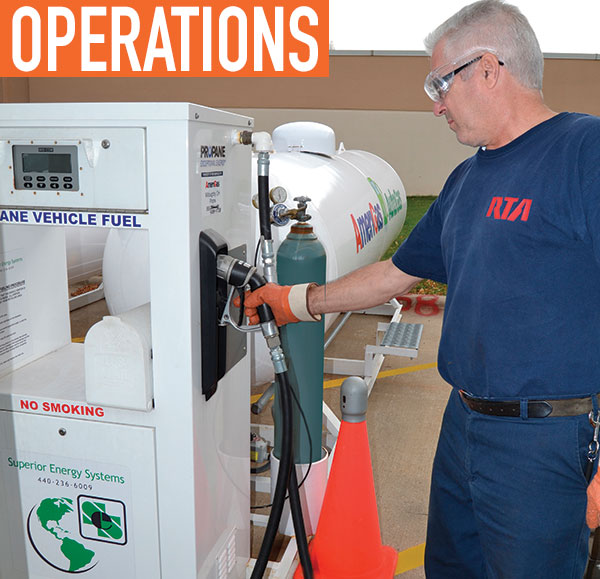Just a few years ago, it was challenging for a work truck fleet operator to capture data proving propane autogas vehicles made business sense.
Sure, there were fleet management systems for autogas, but public and private fleet operators had to rely on their drivers to submit their receipts after fueling. Then, they had to rely on other company personnel to input that data. Along the way, there was high potential for errors before any data analysis could begin.
Seems a little archaic, doesn’t it? That’s why it’s good to know that there is an easier way for work truck fleet operators to acquire data today—by capturing it at the dispenser when a driver refuels.
Today’s new wave of user-friendly autogas dispensers are fully integrated into a fleet operation. Many are customizable and web-based, meaning accurate data is available through any computer connected to the Internet. Web interconnectivity means data can be reviewed from all dispensers located across a city, state, region—or the entire nation.
PROPANE AUTOGAS, BIG DATA
We live in the era of Big Data, where insights from data analysis drive decision-making in most organizations. But, what good is data unless we can use it to act on—to prove or disprove whether a product or service is performing as expected.
Take fleet operators who are mulling over adopting vehicles fueled by autogas. Many organizations, such as propane suppliers, fuel system manufacturers, and the Propane Education & Research Council (PERC), will offer information about why this alternative fuel makes sense. They will tell you that autogas is a clean, abundant, and domestic fuel that’s both economical and safe, and results in reduced costs and better performance. That’s all true, but the data points—the numbers on a spreadsheet—are how fleet operators prove to themselves that the fuel will achieve their goals.
It wasn’t always that way. Decades ago, in the days before any type of computer-based fleet management system, autogas vehicle data either wasn’t captured, or if it was, it was written down manually on an accounting ledger. Fast-forward to the 2000s when third-party fuel management systems for autogas appeared. Even then, fleet operators still had to rely on drivers to submit their receipts and on data-entry people to physically key in information, such as driver name and number. But, what if a driver’s penmanship was sloppy or the data-entry person was distracted?
Today, data management is different—it’s better suited to the decisions that fleet operators must make in order to prove that autogas makes sense as an alternative fuel. A driver pulls up to a web-connected autogas dispenser, identifies himself through a keypad, and enters his personal identification number, vehicle number, mileage, and any of the custom data fields his company requires. Some dispensers, such as the PRO-Vend 2000 from Superior Energy Systems, can track this data for a virtually unlimited number of vehicles, drivers, and customers.
When the driver is done fueling, the data—in the form of an encrypted file—is immediately delivered to a secure cloud database. From there, the fleet operator can view the data through a secure website (in the case of Superior Energy Systems, that’s www.sesautogas.com) and export that data into a spreadsheet that runs reports customized to the operation’s needs and goals. What’s more, some dispensers are sophisticated enough to send an email when a driver’s transaction is complete—meaning data acquisition is in real time.
These autogas dispensers will typically capture several baseline data points:
- Driver name
- Vehicle
- Date
- Time
- Gallons pumped
- Odometer reading
But, they can also provide a number of custom fields that are specific to the fleet operator’s business, such as:
- Route number
- Fleet number
- A specialized accounting number
With all those data points captured by the dispenser, fleet operators can focus less time and effort on acquiring the info and more on the analysis. Tailored system reports will prove whether the fleet department is meeting its goals. Fleet operators can even import that data into a third-party fuel management system and compare how their vehicles fueled by autogas are performing compared to their gasoline or diesel vehicles.
DATA PROVIDES EVIDENCE
Talk is cheap. It’s data that supplies the evidence proving propane autogas is delivering the expected results for a work truck fleet operator. Capturing actionable data in real time at the dispenser level may be unprecedented in the 100-year history of autogas as an engine fuel, but it’s welcome news to fleet operators whose goals are to run a more efficient, cost effective, and environmentally friendly operation.
ABOUT THE AUTHOR:
Mike Walters is vice president of safety and training for Superior Energy Systems, based in Columbia Station, Ohio. For more than 40 years, the company has supplied propane infrastructure and services, bringing together engineering, manufacturing, and construction expertise while focusing on operational excellence and turnkey systems.
_______________________________________________________________________
MODERN WORKTRUCK SOLUTIONS: MAY 2017 ISSUE
Did you enjoy this article?
Subscribe to the FREE Digital Edition of Modern WorkTruck Solutions magazine.
![]()




